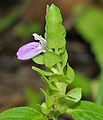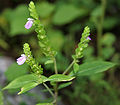You are here
Magnoliopsida
Justicia L.
EOL Text
Barcode of Life Data Systems (BOLDS) Stats
Public Records: 0
Specimens with Barcodes: 6
Species With Barcodes: 1
Barcode of Life Data Systems (BOLDS) Stats
Public Records: 0
Specimens with Barcodes: 2
Species With Barcodes: 1
Justicia is a genus of flowering plants in the family Acanthaceae. There are 658 species with a further 611 species as yet unresolved by Kew. [2] They are native to tropical to warm temperate regions of the Americas, India and Africa. Common names include water-willow and shrimp plant, the latter from the inflorescences, which resemble a shrimp in some species. The generic name honours Scottish horticulturist James Justice (1698-1763).[3] They are closely related to Pachystachys.[4]
Description[edit]
They are evergreen perennials and shrubs with leaves which are often strongly veined; but they are primarily cultivated for their showy tubular flowers in shades of whitre, cream, yellow, orange or pink. They are not hardy below 7 °C (45 °F), so may be grown under glass in frost-prone areas.[4]
Selected species[edit]
Justicia americana (American water-willow), is native to eastern North America north to southern Ontario; it is the hardiest species in the genus, hardy to USDA Plant Zone 4. Justicia ovata (looseflower water-willow) occurs nearly as far north, reaching Michigan.
Justicia brandegeeana (formerly Beloperone guttata, commonly called shrimp plant) is native to Mexico. It is hardy to −4 °C but will often recover in the spring after freezing back in USDA Plant Zone 8a.
Justicia carnea (formerly Jacobinia carnea, common names including Brazilian plume flower, flamingo flower, and jacobinia) is native to South America in southern Brazil, Paraguay and northern Argentina. It is hardy to −2 °C but will often recover in the spring after freezing back in USDA Plant Zone 8a.
Justicia procumbens is procumbent herb with angular stems, swollen at nodes, small ovate leaves, small purple flowers in terminal spikes, inserted didynamous stamens, and shortly bilobed stigmas.
Synonyms[edit]
Genera which have been brought into Synonymy with Justicia include Acelica, Adhatoda, Amphiscopia, Anisostachya, Aulojusticia, Averia, Beloperone, Calliaspidia, Calymmostachya, Chaetothylopsis, Chiloglossa, Cyphisia, Cyrtanthera, Cyrtantherella, Dianthera, Dimanisa, Drejerella, Duvernoia, Emularia, Ethesia, Glosarithys, Harnieria, Heinzelia, Hemichoriste, Heteraspidia, Ixtlania, Jacobinia, Kuestera, Libonia, Lophothecium, Lustrinia, Nicoteba, Orthotactus, Parajusticia, Petalanthera, Plagiacanthus, Plegmatolemma, Porphyrocoma, Psacadocalymma, Rhacodiscus, Rhiphidosperma, Rhyticalymma, Rodatia, Rostellaria, Rostellularia, Saglorithys, Salviacanthus, Sarotheca, Sericographis, Simonisia, Solenochasma, Stethoma, Tabascina, Thalestris, Thamnojusticia, and Tyloglossa.[6]
Gallery[edit]
-
Typical habitat of American Water-willow (Justicia americana) on the Coosa River near Wetumpka, Alabama
-
Justicia trinervia in Talakona forest, in Chittoor District of Andhra Pradesh, India.
-
Justicia procumbens var. simplex near Talakona forest, in Chittoor District of Andhra Pradesh, India.
-
Justicia procumbens in Talakona forest, in Chittoor District of Andhra Pradesh, India.
-
Justicia trinervia in Talakona forest, in Chittoor District of Andhra Pradesh, India.
-
Justicia trinervia in Talakona forest, in Chittoor District of Andhra Pradesh, India.
-
Justicia trinervia in Talakona forest, in Chittoor District of Andhra Pradesh, India.
-
Justicia coccinea in El Crucero, Managua, Nicaragua.
References[edit]
- ^ "Genus: Justicia L.". Germplasm Resources Information Network. United States Department of Agriculture. 2009-01-23. Retrieved 2010-05-26.
- ^ http://www.theplantlist.org/1.1/browse/A/Acanthaceae/Justicia/
- ^ Austin, Daniel F. (2004). Florida Ethnobotany. CRC Press. p. 381. ISBN 978-0-8493-2332-4.
- ^ a b RHS A-Z encyclopedia of garden plants. United Kingdom: Dorling Kindersley. 2008. p. 1136. ISBN 1405332964.
- ^ "Justicia". Integrated Taxonomic Information System. Retrieved 2010-09-20.
- ^ Plant Systematics: Justicia
| License | http://creativecommons.org/licenses/by-sa/3.0/ |
| Rights holder/Author | Wikipedia |
| Source | http://en.wikipedia.org/w/index.php?title=Justicia&oldid=648603655 |
Rostellaria is a genus of sea snails, marine gastropod mollusks in the family Strombidae, the true conchs.[1]
The genus Rostellaria has become a synonym of Tibia Röding, 1798
Species[edit]
- Species brought into synonymy
- Rostellaria brevirostris Schumacher, 1817 : synonym of Tibia insulaechorab Röding, 1798
- Rostellaria curta G.B. Sowerby II, 1842 : synonym of Tibia curta (G.B. Sowerby II, 1842)
- Rostellaria curvirostra Lamarck, 1816 : synonym of Tibia insulaechorab Röding, 1798
- Rostellaria delicatula G. Nevill, 1881 : synonym of Rostellariella delicatula (G. Nevill, 1881)
- Rostellaria dentula Perry, 1811 : synonym of Tibia insulaechorab Röding, 1798
- Rostellaria ionica Perry, 1811: synonym of Tibia fusus (Linnaeus, 1758)
- Rostellaria lorenzi Morrison, 2005:[2] synonym of Rostellariella lorenzi Morrison, 2005
- Rostellaria magna Mörch, 1852 : synonym of Tibia insulaechorab Röding, 1798
- Rostellaria powisii Petit de la Saussaye, 1840 : synonym of Rimellopsis powisii (Petit de la Saussaye, 1840)
- Rostellaria rectirostris Lamarck, 1822 : synonym of Tibia fusus (Linnaeus, 1758)
- Rostellaria sinensis Perry, 1811 : synonym of Tibia fusus (Linnaeus, 1758)
- Rostellaria subulata Lamarck, 1801 : synonym of Tibia fusus (Linnaeus, 1758)
References[edit]
- ^ Rostellaria Lamarck, 1799. WoRMS (2010). Rostellaria Lamarck, 1799. In: Bouchet, P.; Gofas, S.; Rosenberg, G. (2010) World Marine Mollusca database. Accessed through: World Register of Marine Species at http://www.marinespecies.eu/aphia.php?p=taxdetails&id=204325 on 1 May 2011.
- ^ Rostellaria lorenzi Morrison, 2005. Retrieved through: World Register of Marine Species on 27 June 2010.
| License | http://creativecommons.org/licenses/by-sa/3.0/ |
| Rights holder/Author | Wikipedia |
| Source | http://en.wikipedia.org/w/index.php?title=Rostellaria&oldid=594918195 |
Shrubs or herbs. Leaves opposite. Inflorescence a large terminal spike with large sometimes coloured bracts. Calyx lobes equal or upper one narrower. Corolla large, showy, white or red, strongly 2-lipped; lobes very unequal. Fertile stamens 2, attached at base of the corolla tube; two staminodes sometimes also present. Fruit a capsule. Seeds 4.
| License | http://creativecommons.org/licenses/by-nc/3.0/ |
| Rights holder/Author | Mark Hyde, Bart Wursten, Petra Ballings, Flora of Zimbabwe |
| Source | http://www.mozambiqueflora.com/cult/genus.php?genus_id=2298 |
Pachystachys is a genus of 12 species of flowering plants in the family Acanthaceae, native to rainforest in the Caribbean and Central and South America. They are evergreen perennials and shrubs bearing prominent terminal spikes of flowers with brightly coloured bracts.[1]
The name Pachystachys comes from the Greek for "thick spike", referring to the flower heads.[2] The genus is closely related to Justicia.[1]
The species P. coccinea, P. lutea and P. spicata are found in cultivation. They can be grown outside in subtropical gardens in areas where the temperature does not fall below 10 °C (50 °F). Elsewhere, they can be grown under glass or as houseplants.[1]
List of species[edit]
References[edit]
- ^ a b c RHS A-Z encyclopedia of garden plants. United Kingdom: Dorling Kindersley. 2008. p. 1136. ISBN 1-4053-3296-4.
- ^ Coombes, Allen J. (2012). The A to Z of plant names. USA: Timber Press. p. 312. ISBN 978-1-60469-196-2.
- ^ http://www.ipni.org/index.html
- ^ http://www.theplantlist.org/browse/A/Acanthaceae/Pachystachys/
| License | http://creativecommons.org/licenses/by-sa/3.0/ |
| Rights holder/Author | Wikipedia |
| Source | http://en.wikipedia.org/w/index.php?title=Pachystachys&oldid=607589472 |
Shrubs or annual or perennial herbs. Leaves simple, opposite, entire. Inflorescences cymose. Bract (0-)1. Bracteoles 2. Calyx 4-5-lobed, to near the base. Corolla 2-lipped; upper lip very shortly 2-lobed; lower deeply 3-lobed with raised palate. Stamens 2; thecae 2, lower with a well-defined whitish tail. Ovary 2-locular with 2 ovules per loculus. Capsule cylindric or clavate, (1-)4-seeded. Seeds usually rough.
| License | http://creativecommons.org/licenses/by-nc/3.0/ |
| Rights holder/Author | Mark Hyde, Bart Wursten, Petra Ballings, Flora of Zimbabwe |
| Source | http://www.zimbabweflora.co.zw/speciesdata/genus.php?genus_id=1357 |
Barcode of Life Data Systems (BOLD) Stats
Specimen Records:196
Specimens with Sequences:292
Specimens with Barcodes:220
Species:52
Species With Barcodes:47
Public Records:103
Public Species:27
Public BINs:0
Barcode of Life Data Systems (BOLDS) Stats
Public Records: 0
Specimens with Barcodes: 2
Species With Barcodes: 1




















